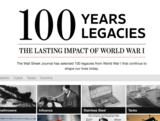
Wall Street Journal interactive that allows students to research and explore 100 ways in which WW1 continues to leave a lasting impact.
- Subject:
- Social Science
- Material Type:
- Interactive
- Provider:
- The Wall Street Journal
- Date Added:
- 11/09/2023

Wall Street Journal interactive that allows students to research and explore 100 ways in which WW1 continues to leave a lasting impact.

Students analyze a photograph of child laborers and make inferences about the impact of the photograph on the photographer based on the message he was trying to convey. Background information about child workers during the Progressive Era included.

Students analyze two letters written by FDR in order to determine the significance that baseball played during WW1 and WW2 in uplifting morale.

This course from the OER Project provides complete lessons, videos, and other resources on the rise of agriculture and early societies, expansion and interconnection among civilizations, economic changes, and so much more!

Students analyze two photographs and make a T-chart to list characteristics of urban and rural life in the early 1900s in New York.

Using primary resources, students analyze WW1 era posters and infer the audience, purpose, and effectiveness of trying to get Americans to conserve food during this time. Online resource. Offers discussion questions.

C3. Inquiry based lesson plan. Students explore the connection between the consumption of sugar and the reliance of slave labor to cultivate sugar plantations. Includes multiple opportunities to explore the supporting questions and develop an argument with claims, including charts, graphs, illustrations, reading excerpts, and background information.

A packet of collaborative activities that allows students to analyze the perspectives of those involved in WW1. Excellent.

Smithsonian resource. Multiple short videos show how American scientists and innovators were prominent in the 1800s and their contributions to society.

This is SHEG activity. They are really good at find Pimarary sources. Frequently the task they ask students to do is a bit above their grade level but with some modification here is a great activity to teach students about the atrocities of the slave trade.

Students will use primary resources to explore the reasons for Western Expansion. They learn why Americans living in the East decided to migrate West and how/why those motivations changed over time. This is an activity for students to analyze documents and put them in chronological order. They then compile a list of reasons for the Western Expansion. Online resource.
This lesson leads students through the creative process of developing analogies to help define a revolution. After they finish, students write a paragraph or page describing revolution using their analogy.

C3 Inquiry based lesson plan offers supporting questions for students to investigate the arguments for and against imperialism as it relates to the United States' involvement in the Spanish-American War. Includes background information, newspaper clippings, newspaper illustrations, campaign speeches, political cartoons, for students to analyze as they develop their evidence-based argument as to whether or not American expansion abroad was (is) justified.

C3. Inquiry based lesson plan. Students investigate the conflicts, conditions, and factors of the western expansion in the U.S. prior to the Civil War. Includes supporting questions and a summative performance task. Also includes a song, maps, charts, excerpts from articles, posters/artwork from the time period, and more for students to analyze as a means of preparing their arguments.
Students will pick a famous person from a revolution and research about that person from several different sources. The student will then need to complete a worksheet that examines the essential questions for this standard. The student will then create a 2 to 3 minute script about the history of this person. The student will then create a background, dress up in time period clothing and present the information to the class.

C3. Inquiry based lesson plan. Using supporting questions and formative performance assessments, students formulate an argument about whether or not the development suburbs was good for America. Focuses on the rapid urbanization following WWII from 1945-1950, students learn about the social and economic conditions of the U.S. during this time as well as the role of government.

Smithsonian. Collection of primary resources shows students the changing role of women during WWII. Each photograph includes guiding questions for discussion. Can be used in many different ways.

This course from the OER Project provides complete lessons, videos, and other resources on much of world history, including the rise of cities, societies, and empires, regional webs, the first global age, industrialization and imperialism in the nineteenth century, World Wars I and II, the Cold War, and globalization.

This WW2 interactive timeline experience allows students to click on important dates during WW2 to show events that happened on a map during that time. Put together by the American Battle Monuments Commission.